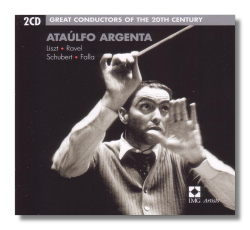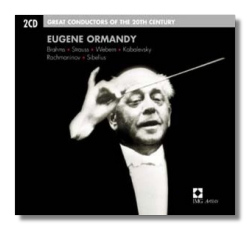
The Internet's Premier Classical Music Source
Related Links
- Latest Reviews
- More Reviews
-
By Composer
-
Collections
DVD & Blu-ray
Books
Concert Reviews
Articles/Interviews
Software
Audio
Search Amazon
Recommended Links
Site News
 CD Review
CD Review
Great Conductors of the 20th Century

Ataúlfo Argenta
- Franz Liszt: A Faust Symphony
- Maurice Ravel: Alborada del gracioso *
- Franz Schubert: Symphony #9, "Great"
- Manuel de Falla: El amor brujo
Orchestre de la Société des Concerts du Conservatoire/Ataúlfo Argenta
* "Orchestre des Cento Soli"/Ataúlfo Argenta
EMI Classics 75097 ADD part monaural 2CDs: 68:58, 74:53


Nikolai Golovanov
- Alexander Glazunov: Symphony #6
- Felix Mendelssohn: A Midsummer Night's Dream: Overture and Scherzo
- Piotr Ilyitch Tchaikovsky: 1812 Overture
- Franz Liszt:
- Orpheus
- Héroïde funèbre
- Mazeppa
- Festklänge
- Prometheus
Moscow Radio Symphony Orchestra/Nikolai Golovanov
EMI Classics 75112 ADD monaural 2CDs: 79:00, 68:57


Nicolai Malko
- Mikhail Ivanovich Glinka: Ruslan & Ludmilla: Overture
- Alexander Borodin: Symphony #2
- Nicolai Rimsky-Korsakoff: The Snow Maiden: Cortège – Dance of the Tumblers
- Piotr Ilyitch Tchaikovsky: The Nutcracker (5 dances)
- Serge Prokofieff: Symphony #7
- Franz Joseph Haydn: Symphony #92, "Oxford" *
- Franz von Suppé: Poet and Peasant: Overture
- Antonín Dvořák: Symphony #9, "From the New World"
- Carl August Nielsen: Maskarade: Overture **
Philharmonia Orchestra/Nicolai Malko
* Royal Danish Orchestra/Nicolai Malko
** Danish State Radio Symphony Orchestra/Nicolai Malko
EMI Classics 75121 ADD part monaural 2CDs: 79:01, 78:30


Eugene Ormandy
- Johannes Brahms: Symphony #4
- Richard Strauss: Don Juan *
- Anton von Webern: Im Sommerwind
- Dmitri Borisovich Kabalevsky: Colas Breugnon: Overture *
- Sergei Rachmaninoff: Symphony #2
- Jean Sibelius: Lemminkäinen's Return
Philadelphia Orchestra
* Bavarian Radio Symphony Orchestra
EMI Classics 75127 ADD part monaural 2CDs: 70:36, 67:35
Collaboration between EMI Classics and IMG Artists has led to the creation of a 15-volume series (at least for now – there is much room for growth) devoted to some of the great (and late) conductors of the previous century. By working with other labels, EMI and IMG have been able to dig deep and to bring many unusual recordings forward; many have not appeared on CD until now.
Ataúlfo Argenta had the misfortune to do the one thing that helps a largely unknown conductor to become a cult figure: he died young. At the age of 44, he succumbed to the banality of accidental carbon monoxide poisoning when he left his car engine running in a closed garage.
The Spanish-born conductor made a handful of recordings for the Decca label and seemed poised for international fame when he died in 1958. Cleverly, EMI has tracked down some of Argenta's less familiar recordings for this interesting collection. Liszt's Faust Symphony, recorded in 1955, is surprisingly intimate and muted – not at all what one expects from this work. Argenta seems uncomfortable with the very idea of bombast, and so this is reading that trades spectacle and showmanship for apologies and insinuation. This means dropping the final chorus and tenor solo of the "Méphistophélès" movement. Apparently Liszt sanctioned this abbreviated edition. The usual version has its longueurs – the "Eternal Womanly leads us on" indeed! – but I don't care for the abbreviated non-apotheosis offered here. The Schubert Ninth, another massive work, also receives an unusual reading; it is more jaunty than "great." Distortions such as the massive rallentando that brings the first movement to a close are the sorts of things Argenta would have worked out of his system if he had reached his 60s. This is young man's Schubert, for better and worse.
On the other hand, his Ravel Alborada del gracioso is idiomatic, characterized by both lean good sense and color. The highlight of this compilation is the music from El amor brujo. Here, the conductor's experience with Spanish zarzuela serves him well, and mezzo-soprano Ana Maria Iriarte, dramatically apt, is less throaty and more "classical" than most singers who are assigned to this music.
The digital remastering updates the sound, but it also throws a spotlight on the often unkempt and timid playing of the two orchestras. (The "Orchestre des Cento Soli" was a recording studio, either an established Paris orchestra in disguise for contractual reasons, or a pick-up group comprised of various French musicians.)
The Golovanov CDs will be a revelation for Western listeners; only indefatigable collectors of Soviet vinyl are likely to be familiar with his work. Golovanov was born in 1891, and at different times during his career, he was principal conductor of the Bolshoi Theater and musical director of the Moscow Radio Symphony Orchestra. He was the first conductor to record a complete Boris Godunov and Sadko, and all of Scriabin's symphonies.
Golovanov's career came to an abrupt end in 1952 when the Kremlin decided that, for whaever reason, the Bolshoi no longer required his services. Not long after, Golovanov died, "not having been able to survive the humiliation," in the words of soprano Galina Vishnevskaya. (The conductor was married to another soprano of note: Antonína Nezhdanova.)
When listening to a Golovanov recording, you feel that the music has been ripped right out of the hands of the composer. Subjectivity has a field day. As annotator Rob Cowan writes, "Learning a work through a Golovanov interpretation is, in a sense, like confronting its prompting inspiration head on." To take that one step further, hearing a familiar work through a Golovanov interpretation can be as shocking as hearing it for the first time. Like Stokowski, Golovanov retouched scores liberally, referring to the "fermatas, caesuras, dynamics, or changes of tempo" as his interpretive "fingerprints." At times, the interpretations define self-indulgence, but where else will you hear such a need to communicate, such a flair for making an intensely visceral impression on the listener?
The 1812 Overture, recorded in 1948, is party material, and I don't mean Communist party! Golovanov's controversial tempos and intensifications of Tchaikovsky's orchestration transform this hackneyed score into a wild beast. When the customary "God Save the Tsar" climax is replaced by a page or two of Glinka (mustn't upset Stalin!), you'll think the rug has been pulled out from beneath you. The Mendelssohn Overture carries fantasy to the extreme, and the coda melts with Golovanov's obvious affection for it. For rushed, sloppy playing, look no further than the Scherzo, but what conviction! The five Liszt tone poems are done with an intensity not even approached in later conductors' pallid recordings; Golovanov conducts as if his life depends on it. The Glazunov Sixth, which also can be a wimpy score, gets a transfusion and shock treatment from the conductor.
The orchestral sound is raw (ugh, those brass instruments!) and the execution is catch-as-catch-can. The harsh engineering is a liability, although it is better than I thought it would be. I fervently urge you to listen past these liabilities and to hear conducting the likes of which we will never hear again. Stupendous, albeit a guilty pleasure!
Going from Nikolai Golovanov to Nicolai Malko is quite a shock, as temperamentally, the difference between the two is the difference between spicy borscht and cool, clear vodka. For a time, however, the two men were following similar paths. Eight years Golovanov's senior, the Russian-born Malko studied in St. Petersburg with Rimsky-Korsakov, Liadov, and Glazunov, and, after World War One, took teaching posts, first in Moscow, and then in St. Petersburg. The première of Dmitri Shostakovich's First Symphony went to Malko, and the score became a "calling card" of sorts for the conductor. However, unlike Golovanov, Malko got out of Russia while the getting was good. In 1928, he left his homeland and freelanced around Europe for a while, forming close ties in London and Copenhagen. He would return to these cities again and again during the rest of his career. In 1940, he came to the United States to teach, but he remained a popular guest conductor in Europe. Late in his career, he became music director of the Sydney Symphony Orchestra in Australia. Malko died in 1961.
Where Golovanov was intensely subjective and free-spirited (and apparently not the strongest practitioner of orchestral discipline), Malko was cool-headed and detail-oriented. (I was not surprised to read that Yevgeny Mravinsky was one of his pupils.) Although Malko's interpretations are relatively free from exaggerated subjectivity, they are rescued from blandness by his concern for color and rhythmic accuracy. Quality playing is never forsaken in favor of breathtakingly fast tempos. One hears this immediately in the Ruslan & Ludmilla Overture. Malko conducts it fairly slowly, but the Philharmonia's well-articulated rhythms and shapely phrases are exciting enough. Malko's earthy Borodin Second challenges Svetlanov's, and it is better played and certainly much better recorded. His Prokofieff Seventh is another classic, and, by the way, the first EMI recording to be made in stereo. (These early stereo EMIs still sound wonderful, with clarity in the bass regions a particular asset.) Malko is warmer than his rivals, notably Rozhdestvensky, whose Prokofieff Seventh wears the chill of old age and death. The Tchaikovsky and Rimsky-Korsakov dances are beautifully poised. Malko's Dvořák is less distinctive (the Scherzo is uncharacteristically sloppy), as is his Haydn, which is nevertheless a scrupulous reading. The Poet and Peasant Overture shows that vulgarity was not a part of this conductor's palette. Malko's mastery was not attention-grabbing, but it was as satisfying then as it is now.
Eugene Ormandy, the most famous of these four conductors, often was taken for granted as his career neared its end, and his reputation has suffered even more since his death in 1985. Recently, I asked a dealer of used classical LPs why Ormandy's recordings were so difficult to find. Ormandy was a prolific conductor, and he must have made hundreds of records, primarily for RCA Victor and Columbia (now Sony). The dealer seemed hard-pressed to conceal his contempt, but satisfied himself by commenting that "Ormandy's records are not in great demand… we can't sell them." This is quite a switch from 1965 or so, when Leonard Bernstein and Eugene Ormandy were the Chevrolet and Ford of classical recordings.
This Ormandy compilation rightly includes samples of his Rachmaninoff and Sibelius, two composers for whom he had particular affinity. The Rachmaninoff Second Symphony that Ormandy recorded in 1973 was one of the first recordings of this score to shun cuts. (Today, uncut recordings are the norm.) It is an eloquent, passionate reading – not a very dark one, but one that sweeps the listener along with the richness of the orchestral sound. The last section of Sibelius's Lemminkäinen Suite gives the lie to those who say Ormandy was a tired, uninteresting conductor at the end of his life. No other conductor's recording blazes and bites as much as this one. EMI's use of the Old Met as a recording venue in 1978 was a stroke of good luck; the pre-digital sound is of demonstration quality.
One wouldn't think that Ormandy and Webern would have much to say to each other, yet the conductor's 1963 recording of Im Sommerwind – the score's first – has yet to be surpassed. Granted, this is an early Webern score and not really typical of him, but Ormandy's informed reading succeeds not primarily through nostalgia but through warmth and clarity.
The other selections are harder to justify. The Brahms Fourth (recorded in 1967) is enthusiastic, but inconsistent with the score's strength and seriousness; this is a rather empty-headed reading. The Bavarian Radio recordings prove that Ormandy was in demand outside of Philadelphia, but they don't add much to our knowledge of him. The Don Juan (1959) is generically exciting but mined with performance glitches. The Colas Breugnon Overture (1965) is better, but if one wanted to show Ormandy's (sometimes forgotten) advocacy of contemporary composers, there were many better alternatives to offer, and in more modern studio sound.
Copyright © 2002, Raymond Tuttle


















